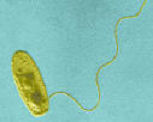Menu
About Us
Products
Legionella Information
Safety Data Sheets
Delivery Costs
Terms and Conditions
Contact Us

Page1, 2, 3, 4, 5, 6, 7, 8, 9, 10, 11, 12, Printable version (.doc 1.35Mb)

The most common method to measure microbiological activity within a cooling system is to use a dip slide. These are commercially available plastic slides which are coated with sterile nutrient agar - a medium on which many micro-organisms will grow, but not Legionella. They are dipped into the water and incubated for 48 hours. Any bacteria in the cooling water will grow and form colonies. Comparison with a chart will indicate the number of bacteria in the water. Dip slides should be dipped in the system water as near to the heat source as possible. If a drain cock is used it is important that any residual water is run off before the slide is dipped. The dip slide should then be replaced into its container and incubated for a minimum of 48 hours in an incubator, usually at 30°C. The incubation period and the temperature should be the same each time the test is performed.
Cooling tower water should be tested, using dip slides (or similar), on a weekly basis. The timing of dip slides and other microbiological sampling is important. Sampling should not be carried out if biocide has been recently added. Neither should the visible condition of the water be taken as a good indicator of the need for sampling; there are a number of chemical additions which render the water opaque. Conversely, relatively clear water may be heavily contaminated with bacteria.
Table 2 lists microbiological counts and the appropriate action that should be taken in response to them. While the number of micro-organisms is itself important, it is also necessary to monitor any changes from week-to-week, particularly if there are any increases in the numbers of micro-organisms detected. This should always result in a review of the system and the control strategies. A graphical representation of these data will often help to monitor any trends.
If the control strategy is effective, the dip slide counts should be consistently low. If an unusually high result is obtained, the test should be repeated immediately and, if confirmed, appropriate action taken (see Table 2). Consistently high microbiological counts using dip slides should be checked by laboratory-based total viable counts (TVC). The laboratory should be accredited by the United Kingdom Accreditation Service (UKAS)
Table 2: Action levels following microbial monitoring for cooling towers
AEROBIC COUNT |
LEGIONELLA BACTERIA |
ACTION REQUIRED |
cfu/ml at 30°C (minimum 48 hours incubation) |
cfu/litre |
|
10,000 or less |
100 or less |
System under control |
Alternative techniques for determining microbiological activity have been developed for on-site use. It is important that such methods can be clearly related to the results achieved by traditional counting methods and that appropriate action levels can be set to inform decisions on the necessary control measures.